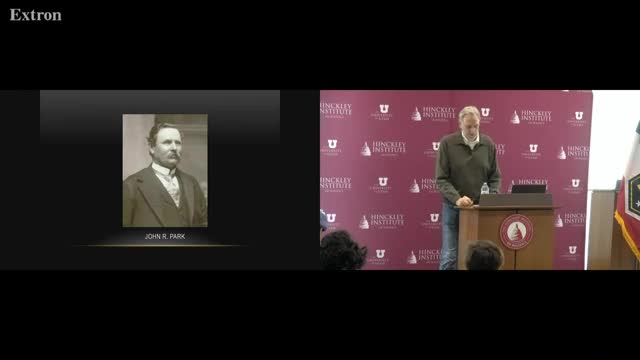University of Deseret rises from ashes to new beginnings
November 14, 2024 | Hinckley Institute of Politics, Citizen Journalism , 2024 -2025 Utah Citizen Journalism, Elections, Utah
This article was created by AI summarizing key points discussed. AI makes mistakes, so for full details and context, please refer to the video of the full meeting. Please report any errors so we can fix them. Report an error »

The University of Deseret, which emerged from a lengthy period of inactivity in 1869, is poised for significant growth under the leadership of its newly appointed president, John R. Park. A graduate of Ohio Wesleyan University and NYU, Park is recognized as the intellectual architect of what would eventually become the University of Utah. His vision for the institution was shaped by extensive tours of European universities, which he hoped to use as models for developing a robust educational framework.
Initially, the university operated from modest accommodations in the Council House at the intersection of South Temple and Main Street, a building that also served as the territorial legislature and a hub for LDS leadership. By 1875, the university's progress led to the establishment of the Timpanogos branch campus in Provo, known today as Brigham Young University.
During this period, Fort Douglas also saw improvements, with soldiers constructing red sandstone buildings from local quarry materials, enhancing the area’s infrastructure. However, the university faced setbacks, including a devastating fire in 1853 that destroyed its original building. This prompted a swift relocation to Union Square, where the institution temporarily occupied a converted hotel.
Recognizing the need for a more suitable home, Park advocated for state funding, resulting in the construction of a new building that would serve as the university's primary location for many years. This period marks a pivotal chapter in the university's history, laying the groundwork for its future as a prominent educational institution in Utah.
Initially, the university operated from modest accommodations in the Council House at the intersection of South Temple and Main Street, a building that also served as the territorial legislature and a hub for LDS leadership. By 1875, the university's progress led to the establishment of the Timpanogos branch campus in Provo, known today as Brigham Young University.
During this period, Fort Douglas also saw improvements, with soldiers constructing red sandstone buildings from local quarry materials, enhancing the area’s infrastructure. However, the university faced setbacks, including a devastating fire in 1853 that destroyed its original building. This prompted a swift relocation to Union Square, where the institution temporarily occupied a converted hotel.
Recognizing the need for a more suitable home, Park advocated for state funding, resulting in the construction of a new building that would serve as the university's primary location for many years. This period marks a pivotal chapter in the university's history, laying the groundwork for its future as a prominent educational institution in Utah.
View full meeting
This article is based on a recent meeting—watch the full video and explore the complete transcript for deeper insights into the discussion.
View full meeting

